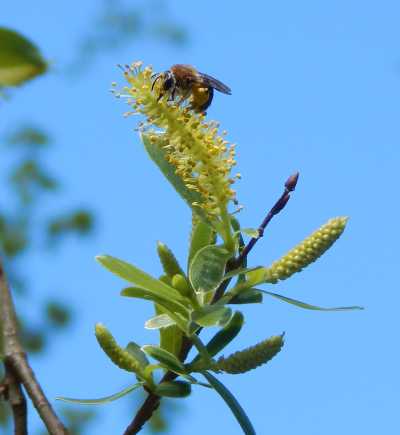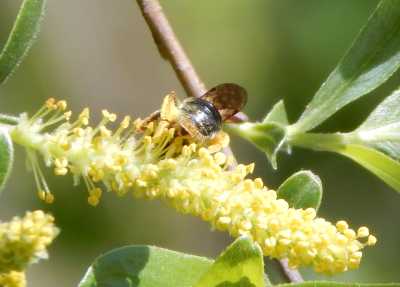Orange-tailed Mining Bee - Andrena haemorrhoa
I count myself very lucky indeed to live in an area with a variety of landscape types that can support a fabulous variety of bee species. Including this one – the Orange-tailed Mining Bee - Andrena haemorrhoa – otherwise known as the ‘early mining bee’. If I could only take better photographs, then I could do them justice!
Anyway, we have coastal habitats with areas of Special
Scientific Interest, woodlands, wildflower habitat and even brownfield
sites that support a variety of flora and fauna. Not to mention gardens, farmland, and traditional
country lanes complete with old hedgerows, and the local council are quite good, with a fair number of roadside verges left to flower naturally.
Foraging habits of the orange-tailed mining bee
 Andrena haemorrhoa - Orange-tailed mining bee feeding on willow catkin.
Andrena haemorrhoa - Orange-tailed mining bee feeding on willow catkin.I took these photographs of the orange-tailed mining bee in a wooded valley with a reservoir, at the bottom of the road where I live.
However, you don't need to have a wooded valley close by to spot these bees. Andrena haemorrhoa can be seen in a variety of habitats, as long as food plants and suitable nest sites are available. Hawthorns, prunus, maples, apple, and willow all provide food for this species. (Indeed, I often encourage new 'bee spotters' to remember to look up at blossoming trees, as well as down at the flower beds). Our local wooded valley has these, and there are plenty of gorse shrubs, dandelions, wood anemones and buttercups to top up the pollen and nectar supplies.
In the UK, these lovely bees can be seen from around
March to July, depending on geography, when these trees and plants are in bloom.
Andrena haemorrhoa - characteristics
These photographs are of a female Andrena haemorrhoa. Females are between 8 and 10mms, with the males a little smaller at 7–9.5 mm, according to Steven Falk, author of Field Guide to the Bees of Britain and Ireland.
The thorax is a dark orange, whilst the abdomen is very dark, but look very closely at these photographs below – admittedly not
brilliant, nevertheless, you can just see a few bright orange hairs on the tip
of the tail in each image. The orange hairs can also be seen in the image at the top of this page, if you look very closely.
 Rear view of Andrena haemorrhoa - Orange-tailed mining bee, showing orange hairs at the tip of the tail.
Rear view of Andrena haemorrhoa - Orange-tailed mining bee, showing orange hairs at the tip of the tail.Nesting habits
These bees nest on south-facing, grassy
slopes. They may nest singly, or in
small groups.
Parasites
Look out for the wasp-like cleptoparasitic bee – the cuckoo species Nomada ruficornis. They may be seen flying around nest holes of orange-tailed mining bees. Nomada ruficornis are able to detect nests that are still being provisioned by the host. Whilst away from the nest, Nomada ruficornis enters the nest and lays an egg, then leaves. The host orange-tailed mining bee then finishes providing for her nest and eggs, and seals up the nest. Later, the cuckoo Nomada ruficornis hatches, eats the grub or egg of the host, and also the food supplies.
Mining bees...
- The Ashy Mining Bee - Andrena cineraria Identification, photos, habitat and nesting habits, parasites and flowers visited by this lovely bee.
- Painted mining bee - Andrena fucata - A medium-sized mining bee, with females around 9mm long, and males a little smaller. They are univoltine.
- The Chocolate Mining Bee - Andrena carantonica/scotica Images of 2 Chocolate mining bees mating, plus their habitats, nesting and foraging preferences.
- Grey-patched mining bee - Andrena nitida Images and description.
- Orange-tailed Mining Bee - Andrena haemorrhoa About the Orange-tailed Mining Bee: photos, habitat, foraging habits. Look out for the bright orangey hairs on the tip of the tail.
If you found this page helpful or interesting, I'd really be grateful if you would share it with others - if not this page, perhaps another, such as Gardening For Bees.
Thank you so much :) .